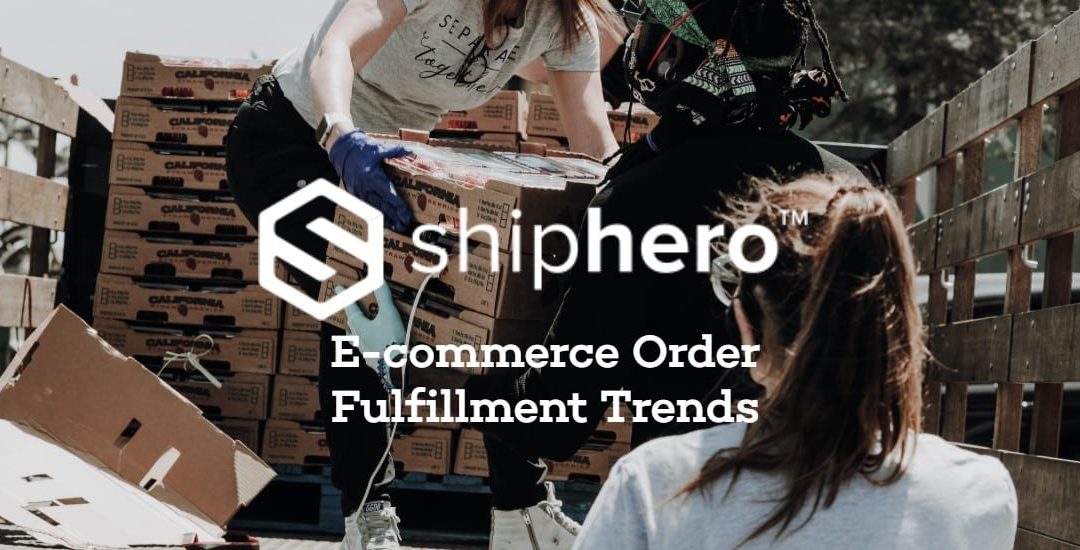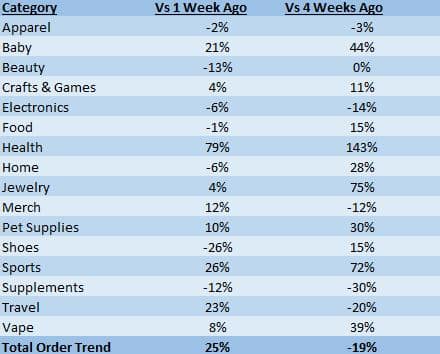
Dec 10, 2020 | Blog, Warehouse Management Software
Aaron Rubin is a longtime veteran of ecommerce. His growing annoyance with the shipping costs related to his business drove him to create ShipHero, a remote company that offers outsourced ecommerce fulfillment services and warehouse management software to other ecommerce businesses.
Recently, more than 1 in every 200 ecommerce packages delivered in America were shipped through ShipHero.
Aaron was interviewed on the Tropical MBA Podcast, discussing how his first ecommerce business nearly went bankrupt, how a need to “scratch his own itch” led to the creation of ShipHero, and offered his take on where the ecommerce industry is headed in the future.
Listen to the podcast here.

Dec 7, 2020 | Blog, News & Updates, Warehouse Management Software
Dearly Beloved,
We are gathered here today to honor the memory of our dear friend, Black Friday, or as her best friends affectionately called her, B.F.
Hear ye, Black Friday was a good Friday, surely not as good as Good Friday, but close. Nay, who could forget how Black Friday enticed all of the stuffed and happy Thanksgivingites to venture from their eating dens into the shoppe world, so that they may purchase holiday tokens and trinkets for their loved ones. She will truly be remembered as a barranger of holiday spirit and- what?
She’s… She’s just quarantined?!… But, CNN said so. They weren’t SURE? I had all this stuff prepared, unbelievable.
So, is Black Friday actually deceased like everyone predicted, or is she quarantined? What does the coroner have to say about the data?
Let’s Start With the Facts
For the sake of uniformity, and to get a bit nostalgic, let’s level-set on what Black Friday is/was.
Black Friday is the Friday after Thanksgiving and has been regarded as the beginning of the United States Christmas shopping season since 1952, with 30% of all shopping occurring between Black Friday and Christmas.
Since the rise of ecommerce, Black Friday has been widely regarded as the brick-and-mortar holiday, physically getting off your rump to purchase items, while Cyber Monday was the “celebration” of online sales.
To combat the hordes of rambunctious shoppers that would flock the stores every year, retail stores started opening earlier and earlier, even into Thanksgiving day. As such, retail stores in 2019 saw a 6.2% decrease in day-of Black Friday traffic with a 2.3% increase in Thanksgiving day traffic, hinting to a possibility that the Black Friday tradition may soon become obsolete.
Even way back in 2019, shoppers were becoming disillusioned with the Black Friday horror stories, avoiding the trampling crowds and opting to shop from the safety of their home. That may in part explain why Black Friday 2019 consumer spending hit a record $7.4 billion online.
Heading into 2020, experts and projections seemed to predict that this trend would continue, with in-store traffic steadily dwindling while online shopping carried the difference. But nobody could have predicted the actual outcomes.
Black Friday 2020
On Black Friday 2020, U.S. store traffic plummeted by 52% as retailers cut their hours and limited their deals in order to dutifully mitigate large gatherings.
Meanwhile, online shopping on Black Friday increased 21.6% YOY to $9.03 billion. If you’re thinking, a 52% decrease and a 22% increase, that doesn’t add up, well… you’re right.
According to statistics accumulated by Adobe Analytics, the month of November in 2019 reported $142.4 in online revenue, and the predicted online revenue for 2020 was a staggering $189 billion. So what did we actually hit? A mere $100 billion, basically a Jeff Bezos weekend.
People just weren’t in the mood to shop in November 2020… except in the case of Small Business Saturday which enjoyed about a 30% YOY growth, which makes sense because a Google research report this year indicated shoppers’ loyalty to small businesses has increased, as 66% say they plan to shop at local small businesses this holiday season.
So after looking at all these figures, can we definitively say that Black Friday has perished? That just seems so final. So permanent.
How COVID Measures Could Revive Black Friday
Consider this, the reason for Black Friday’s impending obsolescence was that shoppers and retailers alike couldn’t handle the large crowds. To address the problem, retailers didn’t implement a new system or improve their practices, instead they paid people more money to come in on a holiday.
Now may I ask, weren’t retailers recently pressured by a shall-remain-unnamed external force to implement a whole bunch of measures, like curbside pickup, contactless checkout and BOPIS, to avoid crowds altogether and improve the shopping experience?
These new omni-channel methods, while a result of necessity, could prove to be a big advantage when the holiday shopping floodgates open up next year in 2021: A Shop Odyssey.
Of course, this is just an optimistic perspective from a Black Friday enthusiast, but it will certainly be interesting to see how retailers employ their newfound capabilities in a post-COVID era of retail.
Push to Digital
Of all the mysteries shrouding Black Friday’s possible disappearance, there is still one very clear trend: the push to online sales for retailers.
Shopify Plus research data indicates the following trends for BFCM 2020:
- 80% of Shopify Plus merchants surveyed who are participating in BFCM plan to only offer online sales, while 20% plan to embrace a hybrid approach.
- 67% plan to sell through an online marketplace, including Amazon and Google Shopping.
- Most brands will offer some type of discount for BFCM, and most will provide a blanket discount on all items.
Not only that, ShipHero collected the following statistics:
- Cyber Monday volume was up 124.14% YOY, more than double that of 2019.
- For the Black Friday to Cyber Monday period, average order value was up 15.36% YOY, increasing to $91.59 from $79.40 a year ago.
- Also during this period, ShipHero total unit volume increased 104.06% YOY.
Online orders increased on both Black Friday and Cyber Monday. With the already overwhelmed fulfillment providers like Amazon, UPS and others reporting delays, volume restrictions or stalls in their fulfillment capabilities, more and more retailers are switching to alternative fulfillment providers. ShipHero saw a large growth in new customers, as well as revenue increases at existing customers.
As we continue to navigate the most wonderful and turbulent time of the year, ShipHero is here to meet your customers’ demands during the holidays and year-round, with fast and accurate order fulfillment. Find out more here.
Dec 1, 2020 | Blog, Fulfillment, Warehouse Management Software
ShipHero Ecommerce Order Fulfillment Update
Tuesday, December 1, 2020
ShipHero just completed another successful Black Friday and Cyber Monday, helping our SaaS and fulfillment customers meet their holiday order rush.
Cyber Monday volume was up 124.14% year-over-year, more than double that of 2019.
For the Black Friday to Cyber Monday period, average order value was up 15.36% year-over-year, increasing to $91.59 from $79.40 a year ago.
Also, during this period, ShipHero total unit volume increased 104.06% year-over-year. The more than doubling of orders is due to the growth new customers using ShipHero as well as sales increases at existing customers.
ShipHero is here to meet your customers’ demand during the holidays and year-round, with fast and accurate ecommerce order fulfillment. See what we can do for you here.

Nov 28, 2020 | Blog, Fulfillment, Warehouse Management Software
ShipHero Ecommerce Fulfillment Update
Saturday, November 28, 2020
ShipHero Ecommerce Fulfillment is in high gear as we surpassed our all-time record volume.
Yesterday was our best sales day ever and today will be our second-best ever.
Here are the statistics for Black Friday and today, Saturday November 28:
Black Friday (as defined by UTC, so starting at 7PM Eastern Thursday) ShipHero orders were up 79% year-over-year.
On Saturday (as defined by UTC, so starting at 7PM Eastern Friday) orders were up 117% year-over-year (more than doubling versus last year).
In addition, on Black Friday, the calendar day, as defined by Eastern Time, ShipHero processed 648,847 orders, up 87% year-over-year. Shopify reported being up 58% YoY for that same period.
As always, ShipHero is here to meet the holiday demand with fast and accurate ecommerce fulfillment. See what we can do for you here.

Nov 23, 2020 | Blog, Fulfillment, Warehouse Management Software
ShipHero provides warehouse management software and outsourced ecommerce order fulfillment to over 4,000 brands, processing an annual gross merchandise volume (GMV) of over $5 billion.
In an effort to provide useful data to the DTC community during Covid and the rapid changes occurring in our industry, we are sharing some of the broad segment trends from the products on our platform. Here is the data for the week ended November 23, 2020:

More charts available on data.shiphero.com.
Do you find this information useful? Let us know! Twitter: @weareshiphero or Email al@shiphero.com.




